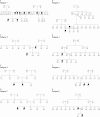The familial contribution to non-syndromic ocular coloboma in south India
- PMID: 12598450
- PMCID: PMC1771576
- DOI: 10.1136/bjo.87.3.336
The familial contribution to non-syndromic ocular coloboma in south India
Abstract
Aims: To identify the proportion of familial cases of isolated ocular colobomatous malformations in a case series from south India.
Methods: Children with ocular coloboma without systemic features were recruited from multiple sources in Andhra Pradesh, India. Their families were traced, pedigrees drawn, and family members examined.
Results: 56 probands, 25 females (44.6%) and 31 males (57.4%) with a colobomatous malformation were identified. In 12 cases (21.4%) another family member was affected. The risk to siblings was 3.8%. The parents were consanguineous in 25 cases (44.6%).
Conclusions: 21.4% of cases of isolated ocular coloboma in this highly consanguineous population of south India were familial, with both autosomal dominant and autosomal recessive mechanisms likely in different families.
Figures
Similar articles
-
Possible autosomal-recessive ocular coloboma.Am J Med Genet. 1981;9(3):189-93. doi: 10.1002/ajmg.1320090304. Am J Med Genet. 1981. PMID: 7282780
-
Clinical spectrum of non-syndromic microphthalmos, anophthalmos and coloboma in the paediatric population: a multicentric study from North India.Br J Ophthalmol. 2021 Jul;105(7):897-903. doi: 10.1136/bjophthalmol-2020-316910. Epub 2020 Aug 22. Br J Ophthalmol. 2021. PMID: 32829301
-
Autosomal dominant typical coloboma associated with unilateral pseudoptosis, myopia and cataract.Cent Afr J Med. 1995 Aug;41(8):255-7. Cent Afr J Med. 1995. PMID: 7585914
-
Phenotypic correlations of ocular coloboma without known cause.Clin Dysmorphol. 1993 Oct;2(4):322-31. Clin Dysmorphol. 1993. PMID: 8305963 Review.
-
Choroidal coloboma in two members of a family.Ophthalmologica. 1998;212(3):208-11. doi: 10.1159/000027281. Ophthalmologica. 1998. PMID: 9562101 Review.
Cited by
-
Consanguinity and Increased Risk of Congenital Ptosis: A Case-Control Study from Southern Iran.J Curr Ophthalmol. 2023 Apr 29;34(4):465-468. doi: 10.4103/joco.joco_136_22. eCollection 2022 Oct-Dec. J Curr Ophthalmol. 2023. PMID: 37180529 Free PMC article.
-
Homozygosity for a hypomorphic mutation in frizzled class receptor 5 causes syndromic ocular coloboma with microcornea in humans.Hum Genet. 2024 Dec;143(12):1509-1521. doi: 10.1007/s00439-024-02712-y. Epub 2024 Nov 6. Hum Genet. 2024. PMID: 39503780 Free PMC article.
-
BMP3 is a novel locus involved in the causality of ocular coloboma.Hum Genet. 2022 Aug;141(8):1385-1407. doi: 10.1007/s00439-022-02430-3. Epub 2022 Jan 28. Hum Genet. 2022. PMID: 35089417
-
Consanguinity and its association with visual impairment in southern India: the Pavagada Pediatric Eye Disease Study 2.J Community Genet. 2019 Jul;10(3):345-350. doi: 10.1007/s12687-018-0401-5. Epub 2018 Dec 1. J Community Genet. 2019. PMID: 30506417 Free PMC article.
-
Keeping an eye on SOXC proteins.Dev Dyn. 2015 Mar;244(3):367-376. doi: 10.1002/dvdy.24235. Epub 2014 Dec 21. Dev Dyn. 2015. PMID: 25476579 Free PMC article. Review.
References
-
- Fujiki K, Nakajima A, Yasuda N, et al. Genetic analysis of microphthalmos. Ophthalmic Paediatr Genet 1992;1:139–49.
-
- Czeizel A, Torzs E, Lujza G, et al. An aetiological study on 6 to 14 year-old children with severe visual handicap in Hungary. Acta Paediatr Hung 1991;31:365–77. - PubMed
-
- Dandona L, Williams JD, Williams BC, et al. Population-based assessment of childhood blindness in southern India. Arch Ophthalmol 1998;116:545–6. - PubMed
-
- Rahi JS, Sripathi S, Gilbert CE, et al. Childhood blindness in India: causes in 1318 blind school students in nine states. Eye 1995;9:545–50. - PubMed
-
- Hornby SJ, Gilbert CE, Rahi J, et al. Regional variation in blindness in children due to microphthalmos, anophthalmos and coloboma. Ophthalmic Epidemiol 2000;7:127–38. - PubMed
Publication types
MeSH terms
LinkOut - more resources
Full Text Sources


